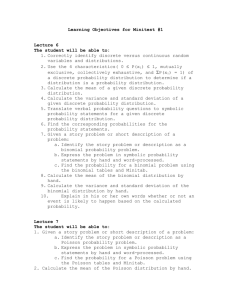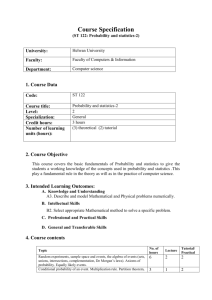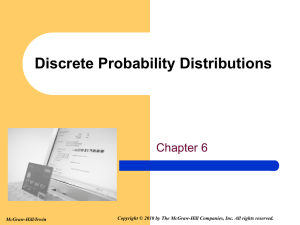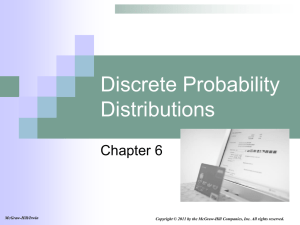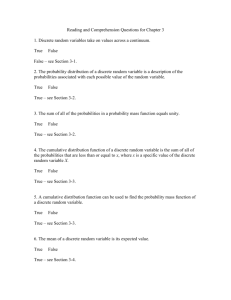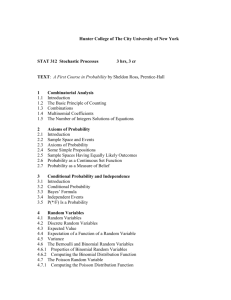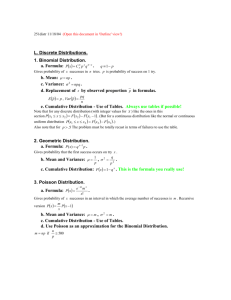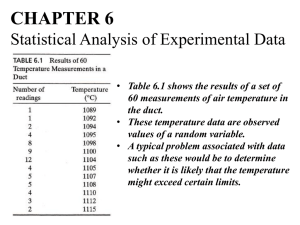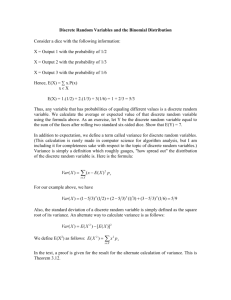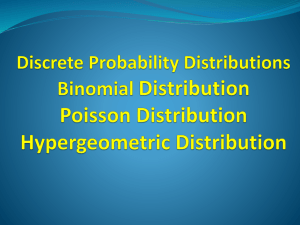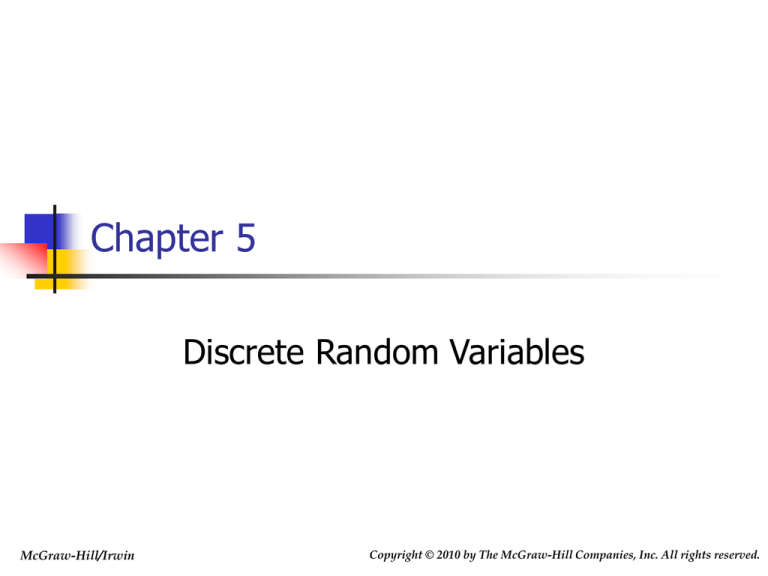
Chapter 5
Discrete Random Variables
McGraw-Hill/Irwin
Copyright © 2010 by The McGraw-Hill Companies, Inc. All rights reserved.
Chapter Outline
5.1
5.2
5.3
5.4
Two Types of Random Variables
Discrete Probability Distributions
The Binomial Distribution
The Poisson Distribution (Optional)
5-2
5.1 Two Types of Random Variables
Random variable: a variable that assumes
numerical values that are determined by the
outcome of an experiment
Discrete
Continuous
Discrete random variable: Possible values
can be counted or listed
The number of defective units in a batch of 20
A rating on a scale of 1 to 5
5-3
Random Variables
Continued
Continuous random variable: May
assume any numerical value in one or
more intervals
The waiting time for a credit card
authorization
The interest rate charged on a business
loan
5-4
5.2 Discrete Probability Distributions
The probability distribution of a
discrete random variable is a table,
graph or formula that gives the
probability associated with each
possible value that the variable can
assume
Notation: Denote the values of the random
variable by x and the value’s associated
probability by p(x)
5-5
Discrete Probability Distribution
Properties
px 0 for each valueof x
p x 1
allx
5-6
Expected Value of a Discrete Random
Variable
The mean or expected value of a
discrete random variable X is:
m X x px
All x
m is the value expected to occur in the
long run and on average
5-7
Variance
The variance is the average of the
squared deviations of the different
values of the random variable from the
expected value
The variance of a discrete random
variable is:
2
X
x m X px
2
All x
5-8
Standard Deviation
The standard deviation is the positive
square root of the variance
The variance and standard deviation
measure the spread of the values of the
random variable from their expected
value
5-9
Example
Table 5.2
5-10
Example
Continued
m x All x xpx
0.03 1.20 2.50 3.20 4.05 5.02
2.1
All x x m x px
2
2
x
0 2.1 0.03 1 2.1 0.20 2 2.1 0.50
2
2
2
3 2.1 0.20 4 2.1 0.05 5 2.1 0.02
2
.89
2
2
5-11
5.3 The Binomial Distribution
The binomial experiment…
Experiment consists of n identical trials
2. Each trial results in either “success” or “failure”
3. Probability of success, p, is constant from trial to
trial
4. Trials are independent
1.
If x is the total number of successes in n
trials of a binomial experiment, then x is a
binomial random variable
5-12
Binomial Distribution
Continued
n!
x n- x
px =
p q
x!n - x !
5-13
Example 5.9
5-14
Binomial Probability Table
p = 0.1
values of p (.05 to .50)
x
0
1
2
3
4
0.05
0.8145
0.1715
0.0135
0.0005
0.0000
0.95
0.1
0.6561
0.2916
0.0486
0.0036
0.0001
0.9
0.15
0.5220
0.3685
0.0975
0.0115
0.0005
0.85
…
…
…
…
…
…
…
0.50
0.0625
0.2500
0.3750
0.2500
0.0625
0.50
4
3
2
1
0
x
values of p (.05 to .50)
P(x = 2) = 0.0486
Table 5.7 (a)
5-15
Several Binomial Distributions
Figure 5.6
5-16
Mean and Variance of a Binomial
Random Variable
m x np
npq
2
x
X npq
2
x
5-17
Example
m x np 8.95 7.6
npq 8.95.05 .38
2
x
X .38 .6164
2
x
5-18
5.4 The Poisson Distribution
(Optional)
Consider the number of times an event
occurs over an interval of time or space,
and assume that
The probability of occurrence is the same for any
intervals of equal length
2. The occurrence in any interval is independent of
an occurrence in any non-overlapping interval
1.
If x = the number of occurrences in a
specified interval, then x is a Poisson
random variable
5-19
The Poisson Distribution
px
e
m
m
x!
Continued
x
5-20
Poisson Probability Table
Table 5.9
5-21
Poisson Probability Calculations
Table 5.10
5-22
Mean and Variance of a Poisson
Random Variable
Mean mx = m
Variance 2x = m
Standard deviation x is square
root of variance 2x
5-23
Several Poisson Distributions
Figure 5.9
5-24

